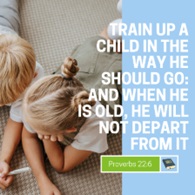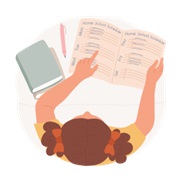 Starting home educating can be confusing and stressful. But if God is leading you there, take heart, as He will provide all you need. My experience with home education has shown that you don’t need the most expensive curriculum or equipment. You just need to love the Lord with all your heart and be committed to the calling He has for you.
Starting home educating can be confusing and stressful. But if God is leading you there, take heart, as He will provide all you need. My experience with home education has shown that you don’t need the most expensive curriculum or equipment. You just need to love the Lord with all your heart and be committed to the calling He has for you.
 Proverbs 22:6 (KJV) says that we should: “ Train up a child in the way he should go: and when he is old, he will not depart from it”. This is often used in connection with Spiritual growth and Bible foundations but it applies to a lot of other things, like respect, manners, how we view the world, who we trust, how we treat others, the list continues. For most families a lot of this education comes from school. After all, they spend up to 6 hours a day 5 days a week there. That’s over 40% of their waking day*. You can then see why Home educating is often a preferred choice for people who want to train their children in God’s way. Not everyone follows this route for those reasons but it is becoming more common and no matter whether you choose this path because of this, or to help a child with special needs, or anxiety, or a child who has sensory regulation issues, or to spend more time with them, or because you travel, or the multitude of other reasons that exist, the truth is you are taking back a lot of time, and taking back control of how and what your children learn. For this reason, when God calls you to Home educate it can feel very daunting, but fear not, God is with you… every step of the way.
Proverbs 22:6 (KJV) says that we should: “ Train up a child in the way he should go: and when he is old, he will not depart from it”. This is often used in connection with Spiritual growth and Bible foundations but it applies to a lot of other things, like respect, manners, how we view the world, who we trust, how we treat others, the list continues. For most families a lot of this education comes from school. After all, they spend up to 6 hours a day 5 days a week there. That’s over 40% of their waking day*. You can then see why Home educating is often a preferred choice for people who want to train their children in God’s way. Not everyone follows this route for those reasons but it is becoming more common and no matter whether you choose this path because of this, or to help a child with special needs, or anxiety, or a child who has sensory regulation issues, or to spend more time with them, or because you travel, or the multitude of other reasons that exist, the truth is you are taking back a lot of time, and taking back control of how and what your children learn. For this reason, when God calls you to Home educate it can feel very daunting, but fear not, God is with you… every step of the way.
There are various fun quizzes that you can do online that will give you a starting point for how they learn, the rest comes with experience. Like this one: Learning Style Quiz | Get started or this one from EducationPlanner.org – What’s Your Learning Style? 20 Questions (educationplanner.org) which you can do without entering an email address.
 No child will have only one learning style, but they may have one way in which they learn best:
No child will have only one learning style, but they may have one way in which they learn best:
- Visual – seeing things (videos, images, charts, experiences at libraries etc.)
- Auditory – listening (audio books, music, discussion, classic lectures, etc)
- Kinesthetic /Tactile – moving and doing. (hands on activities, simulations, role playing, etc)
- Traditional – writing and reading (worksheets, textbooks, notes, reports, etc)
You won’t be able to figure this out right away if you haven’t spent time observing your child learn, older children can fill out a quiz like the one suggested above, for an idea but you may find that you adjust your initial findings as time goes by. Remember that every child is unique and has special gifting granted by our Heavenly Father, and the way in which they learn is also designed by God so that we can all work together as one body, with each part unique and original.
Now you have a better understanding of the basics of different types of learning, we can look at the different home educating methods.
There are several learning methods that can be utilized in home education. The choice of method depends on various factors, including the preferences and learning style of the student, the subjects being taught, and the available resources. Some even implement different styles at different times, it’s all about choosing what is best for you. Pray and God will guide you in the way that you should go.
Here are some popular learning methods used in home education and a few example links.
Traditional/Structured Learning
This approach follows a more formal curriculum with textbooks, workbooks, and lesson plans. It can sometimes mimic the structure of traditional schooling, with specific goals, timelines, and assessments. There are a lot of resources online for this, with great free options like allinonehomeschool, websites that offer free resources like confessions of a homeschooler and the free resources from The Good and the beautiful.
ACE curriculum for Home Educators provided by TEACH
The Good and the Beautiful (goodandbeautiful.com)
My Printables – Confessions of a Homeschooler
Child-Led / Unschooling
This method is all about following your child’s interests and allowing them room to explore them and gain knowledge in the areas that they want to explore. It can be an interesting challenge if you live in an area which requires specific curriculums to be followed but can still be done with a bit of planning and creativity. It is important to note that this style of educating was never intended as an excuse to do no learning and despite the many views that are out their, people who chose to unschool or follow child-led learning ensure that their children are participating in learning by rather opening opportunities for them to learn in a very kinesthetic way while exploring their interests. Children up to the age of 8/9 often spend large amounts of time outside, exploring and learning through play.
My favourite metaphor that I heard about Unschooling was that it is like a feast you present to a child, their eyes wide with excitement about all the ‘goodies’ they get to consume.
Because of the nature of child-led, there are no specific online resources to share, but a quick google of things like lapbooks for x or hands on resources for learning x should start you on your learning journey.
Ever Learning – Eclectic Homeschooling and Beyond
Montessori Inspired
 This method is based on the findings of Maria Montessori who founded Montessori education after her time working with her students. It is a very hands on style with Montessori schools seeing the educators as guides rather than teachers, it is about children learning themselves through self-correcting curriculum and equipment. A lot of which can be modified and re-produced at home. It will require some DIY options if you don’t have enough budget to pay for all the amazing resources you can purchase online either through specific suppliers or through even Amazon. There are also a lot of resources helping you understand the different stages of development that the Montessori method uses and to provide you with curriculum to follow.
This method is based on the findings of Maria Montessori who founded Montessori education after her time working with her students. It is a very hands on style with Montessori schools seeing the educators as guides rather than teachers, it is about children learning themselves through self-correcting curriculum and equipment. A lot of which can be modified and re-produced at home. It will require some DIY options if you don’t have enough budget to pay for all the amazing resources you can purchase online either through specific suppliers or through even Amazon. There are also a lot of resources helping you understand the different stages of development that the Montessori method uses and to provide you with curriculum to follow.
How to Setup Montessori at Home – A Complete Guide | GMN (theglobalmontessorinetwork.org)
Unit Studies
This method breaks learning into project sized chunks where children work on specific projects, doing the research and the work while learning while doing. This can be done with very little resources as long as you have access to a library or internet. This is also a great method to do together at a co-op or group. With each child working on different elements but sharing together the results.
Examples unit study articles:
Honey Bee Unit Study Resources – The Homeschool Scientist
Charlotte Mason
For many using this method, emphasis is put on ‘living books’ and real-life experiences. The Charlotte Mason style sees the importance of developing character, intellect and habits. It encourages literature-based learning, nature studies and many hands-on activities to develop the skills and knowledge needed. There is a whole community of Charlotte Mason home educators around the world and many local communities combine efforts.
You can find a group and more information on this style here Charlotte Mason Together Groups – Simply Charlotte Mason
Fully Online Learning
With the advancements in technology, the options to do learning via courses, lessons, apps and tutoring online has increased dramatically. This method has a wide range of options, from full time school at home (which doesn’t really classify as home education but is included here for an option) to tutoring/lessons, to gamified apps which teach content. For example there are a large range of apps aimed at teaching your child to read, step-by-step. Many people have concerns over the amount of screentime a child has but balance can certainly be achieved by combined some online learning with other forms (see eclectic below).
Here are a few examples of online programs, secular and Christian based.
Immanuel Online School – Fully tutored, Part tutored or Self taught options available
Learning to Read for Kids | Learn to Read with Phonics | Free Trial – Reading Eggs
Online GCSE and A level Science | Southwest Science School
Co-operative Learning
This is more common in the USA but there are certainly groups that get together like those who follow the Classic conversations methods who meet regularly to learn. Responsibilities are usually shared in a co-op with different parents taking on different tasks and rotating learning. The benefit of this is they get to learn in an environment where you can help guide them but still alongside others to learn group working skills and co-operation. Both of these can also be accomplished with the other methods if you join local activity groups for Home educating.
You can connect with other home educators or Facebook groups for Home educators to find if there are any groups running near you or start one yourself.
www.classicalconversations.co.uk
Eclectic
This is a favourite among many home educators and many end up using this method as it simply the combining of all the different methods that work well for you and your family, all discussed above. An example of this could be following a workbook for Maths, going to a drama class, doing nature study and learning to read through an app like Reading Eggs. There is no right or wrong way, it’s a mix that’s based on what you have found to work.
It’s important to note that there is no one-size-fits-all approach, and what works best for one student may not work as effectively for another. Home educating allows the flexibility to tailor the learning experience to the student’s unique needs, interests, and learning style.
Whichever way you chose, prayer is powerful and allowing room to be guided by God will ensure that your home educating experience is a journey filled with great reward, not absent of trials but steeped in peace, knowing God is in control.
May your journey be filled with joy and peace!
Article by Rachael Elder, 2023
*based on a typical school day being 9am – 3pm and an average day being 6am to 8pm.
**CHESS nor the Author are not reimbursed by any of the links shared. They are added for your benefit and considered useful resources.
 Easy Peasy All-in-One Homeschool – A complete, free online Christian homeschool curriculum for your family and mine (allinonehomeschool.com)
Easy Peasy All-in-One Homeschool – A complete, free online Christian homeschool curriculum for your family and mine (allinonehomeschool.com) Easy Peasy All-in-One Homeschool – A complete, free online Christian homeschool curriculum for your family and mine (allinonehomeschool.com)
Easy Peasy All-in-One Homeschool – A complete, free online Christian homeschool curriculum for your family and mine (allinonehomeschool.com)